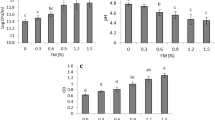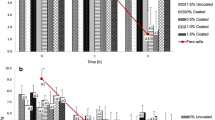Abstract
The assurance of the bacteria survival is the key of the protective technique aiming to alleviate the bacteria resistance under digestive hostilities. Among the methods of protection, microencapsulation of cells in various biomaterials has given convincing results. We tried to exploit for the first time the emulsifying properties of carob galactomannans reinforced herein by the sodium alginate gel in the microencapsulation of beneficial bacteria. On the other hand, we explored the benefits of this protective technique upon the expression of the bacterial ability to uptake cholesterol, in complement to our previously published results. The present study aimed to develop a new mixed gel containing calcium alginate and galactomannans extracted from the Algerian carob seeds endospermes, for the microencapsulation of the human strain of Lactobacillus rhamnosus LbRE-LSAS; compared with the probiotic strain of Bifidobacterium animalis subsp. lactis Bb12. Influence of microencapsulation was tested under simulated digestive environment to verify if both bacteria preserve their viability and their cholesterol assimilation ability. High viable loads of encapsulated LbRE-LSAS and Bb12 were registered (6.97 and 8.66 of 10 Log CFU g−1, respectively). Conversely, the free cell levels strongly (P < 0.05) decreased during exposure to the digestive simulated conditions. According to our results, the new formed gel permits to improve 1.8-fold on average the cholesterol assimilation ability of probiotic bacteria. We underlined the possible use of carob galactomannans-Ca-alginate beads as alternative healthy solution in protecting beneficial bacteria under gastro-intestinal conditions, and by the way, lowering the serum cholesterol level in the host.
Access this chapter
Tax calculation will be finalised at checkout
Purchases are for personal use only
Similar content being viewed by others
References
Chang, T.M., Prakash, S.: Artificial cells for bioencapsulation of cells and genetically engineered E coli. For cell therapy, gene therapy, and removal of urea and ammonia. Methods Mol. Biol. 63, 343–358 (1997)
Dakia, P.A., Blecker, C., Robert, C., Wathelet, B., Paquot, M.: Composition and physiochemical properties of locust bean gum extracted from whole seeds by acid and water dehulling pre-treatment. Food Hydrocoll. 22, 807–818 (2008)
Fareez, I.M., Lim, S.M., Lim, F.T., Mishra, R.K., Ramasamy, K.: Microencapsulation of lactobacillus sp. Using chitosan-alginate-xanthan gum-β-cyclodextrin and characterization of its cholesterol reducing potential and resistance against pH, temperature and storage. J. Food Process Eng. 40, 1–18 (2017)
Fávaro-Trindade, C.S., Grosso, C.R.F.: Microencapsulation of L. acidophilus (La- 05) and B. lactis (Bb-12) and evaluation of their survival at the pH values of the stomach and in bile. J. Microencapsul. 19, 485–494 (2002)
Folch, J., Lees, M., Sloane Stanley, G.H.: A simple method for the isolation and purification of total lipides from animal tissues. J. Biol. Chem. 1, 497–509 (1957)
Hansen, L.T., Lan-Wojtas, P.M., Jin, Y.L., Paulson, A.T.: Survival of Ca-alginate microencapsulated Bifidobacterium spp. in milk and simulated gastrointestinal conditions. Food Microbiol. 19, 35–45 (2002)
Jones, M.L., Chen, H., Ouyang, W., Metz, T., Prakash, S.: Microencapsulated genetically engineered lactobacillus plantarum 80 (pCBH1) for bile acid deconjugation and its implication in lowering cholesterol. J. Biomed. Biotechnol. 1, 61–69 (2004)
Jung, M.H., Seong, P.N., Kim, M.H., Myong, N.H., Chang, M.J.: Effect of green tea extract microencapsulation on hypertriglyceridemia and cardiovascular tissues in high fructose-fed rats. Nutr. Res. Pract. 7, 366–372 (2013)
Kim, S.J., Cho, S.Y., Kim, S.H., Song, O.J., Shin, S., Chu, D.S., Park, H.J.: Effect of microencapsulation on viability and other characteristics in Lactobacillus acidophilus ATCC43121. LWT- Food Sci. Technol. 41, 493–500 (2008)
Markowiak, P., Śliżewska, K.: Effects of probiotics, prebiotics, and synbiotics on human health. Nutrients 9(9), 1021 (2017)
Pereira, D.I.A., Gibson, G.R.: Effects of consumption of probiotics and prebiotics on serum lipid levels in humans. Crit. Rev. Biochem. Mol. Biol. 37, 259–281 (2002)
Ruiz-Roso, B., Quintela, J.C., De la Fuente, E., Haya, J., Pérez-Olleros, L.: Insoluble carob fiber rich in polyphenols lowers total and LDL cholesterol in hypercholesterolemic sujects. Plant Food Hum. Nutr. 65, 50–56 (2010)
Sultana, K., Godward, G., Reynolds, N., Arumugaswamy, R., Peiris, P., Kailasapathy, K.: Encapsulation of probiotic bacteria with alginate-starch and evaluation of survival in simulated gastrointestinal conditions and in yoghurt. Int. J. Food Microbiol. 62, 47–55 (2010)
WHO: Carob bean gum. 82nd JECFA - Chemical and Technical Assessment (CTA) (2016). http://www.fao.org/3/a-br563e.pdf. Accessed 12 Apr 2019
WHO: World Gastroenterology Organisation Global Guidelines: Probiotics and Prebiotics, World Gastroenterology Organisation, Milwaukee, WI (2017)
Yazhini, P., Visha, P., Selvaraj, P., Vasanthakumar, P., Chandran, V.: Dietary encapsulated probiotic effect on broiler serum biochemical parameters. Vet. World 11(9), 1344–1348 (2018)
Ziar, H., Gérard, P., Riazi, A.: Calcium alginate-starch improved the survival of Bifidobacterium animalis subsp. lactis Bb12 and Lactobacillus rhamnosus LBRE-LSAS in yogurt and simulated gastrointestinal conditions. Int. J. Food Sci. Technol. 47, 1421–1429 (2012)
Ziar, H., Gérard, P., Riazi, A.: Effect of prebiotic carbohydrates on growth, bile survival and cholesterol uptake abilities of dairy-related bacteria. J. Sci. Food Agric. 94, 1184–1190 (2014)
Zunft, H.J., Lueder, W., Harde, A., Haber, B., Graubaum, H.J., Koebnick, C., Gruenwald, J.: Carob pulp preparation rich in insoluble fibre lowers total and LDL cholesterol in hypercholesterolemic patients. Eur. J. Nutr. 42, 235–242 (2003)
Author information
Authors and Affiliations
Corresponding author
Editor information
Editors and Affiliations
Rights and permissions
Copyright information
© 2020 Springer Nature Switzerland AG
About this paper
Cite this paper
Ziar, H., Yahla, I., Riazi, A., Gérard, P. (2020). Ca-Alginate-Carob Galactomannans Beads to Preserve Viability During Digestive Hostility Transit and Cholesterol Uptake Ability of Probiotic Bacteria. In: Benmounah, A., Abadlia, M.T., Saidi, M., Zerizer, A. (eds) Proceedings of the 4th International Symposium on Materials and Sustainable Development. ISMSD 2019. Springer, Cham. https://doi.org/10.1007/978-3-030-43268-3_22
Download citation
DOI: https://doi.org/10.1007/978-3-030-43268-3_22
Published:
Publisher Name: Springer, Cham
Print ISBN: 978-3-030-43267-6
Online ISBN: 978-3-030-43268-3
eBook Packages: Chemistry and Materials ScienceChemistry and Material Science (R0)




